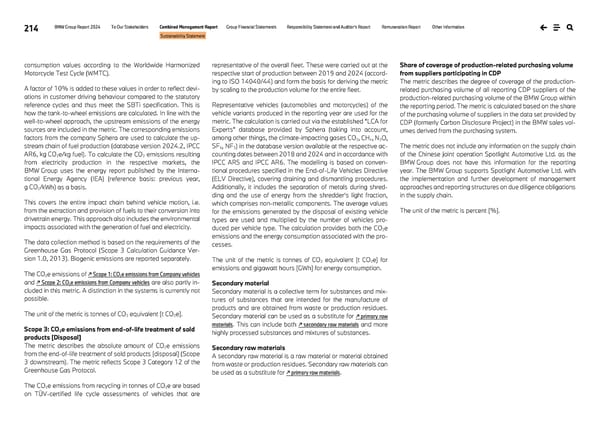214 BMW Group Report 2024 To Our Stakeholders Combined Management Report Group Financial Statements Responsibility Statement and Auditor’s Report Remuneration Report Other Information Sustainability Statement consumption values according to the Worldwide Harmonized Motorcycle Test Cycle (WMTC). A factor of 10% is added to these values in order to reflect devi- ations in customer driving behaviour compared to the statutory reference cycles and thus meet the SBTi specification. This is how the tank-to-wheel emissions are calculated. In line with the well-to-wheel approach, the upstream emissions of the energy sources are included in the metric. The corresponding emissions factors from the company Sphera are used to calculate the up- stream chain of fuel production (database version 2024.2, IPCC AR6, kg CO2e/kg fuel). To calculate the CO2 emissions resulting from electricity production in the respective markets, the BMW Group uses the energy report published by the Interna- tional Energy Agency (IEA) (reference basis: previous year, g CO2/kWh) as a basis. This covers the entire impact chain behind vehicle motion, i.e. from the extraction and provision of fuels to their conversion into drivetrain energy. This approach also includes the environmental impacts associated with the generation of fuel and electricity. The data collection method is based on the requirements of the Greenhouse Gas Protocol (Scope 3 Calculation Guidance Ver- sion 1.0, 2013). Biogenic emissions are reported separately. The CO2e emissions of ↗ Scope 1: CO2e emissions from Company vehicles and ↗ Scope 2: CO2e emissions from Company vehicles are also partly in- cluded in this metric. A distinction in the systems is currently not possible. The unit of the metric is tonnes of CO2 equivalent [t CO2e]. Scope 3: CO2e emissions from end-of-life treatment of sold products [Disposal] The metric describes the absolute amount of CO2e emissions from the end-of-life treatment of sold products [disposal] (Scope 3 downstream). The metric reflects Scope 3 Category 12 of the Greenhouse Gas Protocol. The CO2e emissions from recycling in tonnes of CO2e are based on TÜV-certified life cycle assessments of vehicles that are representative of the overall fleet. These were carried out at the respective start of production between 2019 and 2024 (accord- ing to ISO 14040/44) and form the basis for deriving the metric by scaling to the production volume for the entire fleet. Representative vehicles (automobiles and motorcycles) of the vehicle variants produced in the reporting year are used for the metric. The calculation is carried out via the established "LCA for Experts" database provided by Sphera (taking into account, among other things, the climate-impacting gases CO2, CH4, N2O, SF6, NF3) in the database version available at the respective ac- counting dates between 2018 and 2024 and in accordance with IPCC AR5 and IPCC AR6. The modelling is based on conven- tional procedures specified in the End-of-Life Vehicles Directive (ELV Directive), covering draining and dismantling procedures. Additionally, it includes the separation of metals during shred- ding and the use of energy from the shredder’s light fraction, which comprises non-metallic components. The average values for the emissions generated by the disposal of existing vehicle types are used and multiplied by the number of vehicles pro- duced per vehicle type. The calculation provides both the CO2e emissions and the energy consumption associated with the pro- cesses. The unit of the metric is tonnes of CO2 equivalent [t CO2e] for emissions and gigawatt hours [GWh] for energy consumption. Secondary material Secondary material is a collective term for substances and mix- tures of substances that are intended for the manufacture of products and are obtained from waste or production residues. Secondary material can be used as a substitute for ↗ primary raw materials. This can include both ↗ secondary raw materials and more highly processed substances and mixtures of substances. Secondary raw materials A secondary raw material is a raw material or material obtained from waste or production residues. Secondary raw materials can be used as a substitute for ↗ primary raw materials. Share of coverage of production-related purchasing volume from suppliers participating in CDP The metric describes the degree of coverage of the production- related purchasing volume of all reporting CDP suppliers of the production-related purchasing volume of the BMW Group within the reporting period. The metric is calculated based on the share of the purchasing volume of suppliers in the data set provided by CDP (formerly Carbon Disclosure Project) in the BMW sales vol- umes derived from the purchasing system. The metric does not include any information on the supply chain of the Chinese joint operation Spotlight Automotive Ltd. as the BMW Group does not have this information for the reporting year. The BMW Group supports Spotlight Automotive Ltd. with the implementation and further development of management approaches and reporting structures on due diligence obligations in the supply chain. The unit of the metric is percent [%].
 BMW Group Report 2024 Page 213 Page 215
BMW Group Report 2024 Page 213 Page 215